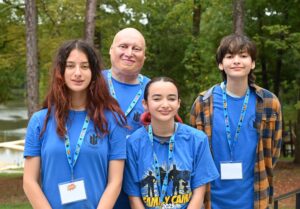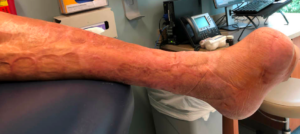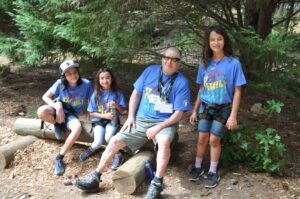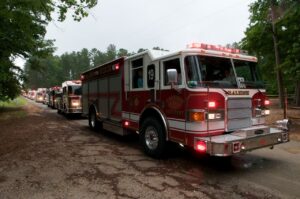Clinical Innovation Enables a Circle of Healing

James January Jr. is a burn survivor whose involvement with UNC Surgery is multi-layered. He survived 3rd degree burns to 85% of his body in 1992. His treatment included xenograft applications, many months in the hospital, and numerous follow-up surgeries of many types. For many years, he has been involved with the Division of Burn Surgery’s North Carolina Jaycee Burn Center as a volunteer. Yet due to the nature of healing, surviving burn injury is only the first step. Burn survivors often have many years of contact with burn and other surgical specialists for follow-up care.

Mr. January lived with peripheral neuropathy and underwent left foot partial foot (trans-metatarsal) amputation in 2018 due to with non-healing wound to the plantar lateral aspect of left foot. He had multiple soft tissue and bone debridement as well as advanced wound care and offloading braces to attempt to heal the wound.
Due to multiple complex factors, his wounds would not heal, and he dealt with recurring infections in his foot near the scarred skin from his burn injury. He also lived with neuropathy and deformity of his hindfoot and ankle. Clinically, these factors caused him to overload outer (lateral plantar) part of his left foot while walking leading to a then chronic non-healing wound. He also developed bone infection multiple times and was treated with bone debridements and long term IV antibiotics.
A below the knee amputation option was offered. However, this would be a difficult amputation to heal from due to previous burn injury and scar tissue formation circumferentially around the leg. Additionally, he would not be a good candidate for prosthesis due to circumferential scar tissue in the leg and not being able to bear weight on his fragile scarred skin.
For these reasons he was referred to (the limb salvage) clinic for reconstruction and deformity correction and wound closure as an attempt for limb salvage.
Vascular + Podiatry = Innovative Excellence
Nearly 25 years ago, Division of Vascular Surgery Chief William Marston had a vision. Recruiting Podiatrists with specialized training in peripheral vascular disease and limb salvage to the team began in 1999 (starting with Dr. Kashefsky part-time), then excelled on to full-time faculty members 13 years ago. This vision propelled UNC to be a regional and a national leader in limb salvage. By working closely with the vascular surgery team, Podiatrists have performed over 300 operations every year focusing on lower limb salvage by preventing major amputations, diabetic charcot foot and ankle reconstruction with application of lizarov external fixation and plastic surgical reconstruction of diabetic foot and ankle.
Clinical Innovation at Work: James January’s Limb Salvage Surgery by Dr. Shrunjay Patel

The team cared for James January with a multidisciplinary team approach towards limb salvage. Through working closely with the Infectious Disease team at UNC and with team effort, the Podiatry Team (led by Dr. Patel) was successfully able to eradicate the bone infection in Mr. January’s foot. Next the team utilizing a staged approach: First Dr. Patel performed realignment surgery and performed hindfoot and ankle fusion and application of Ilizarov circular multiplanar external fixation system. He also performed local rotational skin flap to close the wound.
After approximately 2 months of healing from initial surgery, Mr. January was taken back to the operating room for removal of all hardware from his foot and leg. His wounds healed completely and his deformity was completely corrected.

He was transitioned to a supportive custom shoe with weight bearing as tolerated. He has remained healed without recurrence of deformity or infection and has been able to ambulate without any complications for over a year now. He is very happy to have his life back without wounds and he is extremely grateful and delighted with his outcome of limb salvage surgery at UNC.
On Survivorship, Surgeries, and Giving Back
James January exemplifies the impact of UNC’s care and its inspiration for him to give back to the burn community. Near the end of his inpatient stay in 1992, his physical therapist invited him to speak on the patient perspective, things that one needs to consider, approaches one needs to make, etc. With Burn Center staff, he lectures on his own treatment and healing, including from initial burn care and more recent limb surgeries. He is involved in the Burn Center’s Aftercare programs on multiple levels as well. January brings his own children to Family Camp to benefit from the connects and supportive environment, and volunteers as a Camp Celebrate Counselor as service to other survivors.
Burn Center Aftercare: Support for Survivors and Loved Ones Across Life Stages
 The emotional work of healing after burn injury occurs largely after discharge. Aftercare programming meets emotional and psychosocial needs of survivors and their families. It educates them about what to expect along the extensive road of recovery after traumatic injury. Most importantly, Aftercare offers opportunities and tools necessary to heal and to make the most positive transition from burn victim to burn survivor. UNC is home to the oldest burn aftercare program in the United States. Camp Celebrate is a weekend camp for children ages 7-15 who have survived burn injuries. Created in 1982 in response to an inability to find traditional camping opportunities for a group of young burn patients at the North Carolina Jaycee Burn Center, Camp Celebrate was the first camping experience of its kind. Many campers return year after year. Especially poignant are the stories of survivors who return as adults to serve as counselors and share their experiences and knowledge with the children. Aftercare programs are so impactful because they provide a sense of connection with fellow survivors and the center staff, a trajectory of healing and hope.
The emotional work of healing after burn injury occurs largely after discharge. Aftercare programming meets emotional and psychosocial needs of survivors and their families. It educates them about what to expect along the extensive road of recovery after traumatic injury. Most importantly, Aftercare offers opportunities and tools necessary to heal and to make the most positive transition from burn victim to burn survivor. UNC is home to the oldest burn aftercare program in the United States. Camp Celebrate is a weekend camp for children ages 7-15 who have survived burn injuries. Created in 1982 in response to an inability to find traditional camping opportunities for a group of young burn patients at the North Carolina Jaycee Burn Center, Camp Celebrate was the first camping experience of its kind. Many campers return year after year. Especially poignant are the stories of survivors who return as adults to serve as counselors and share their experiences and knowledge with the children. Aftercare programs are so impactful because they provide a sense of connection with fellow survivors and the center staff, a trajectory of healing and hope.
“As time progressed I got better doing what I do and started doing more than just lectures…all while enduring the ups & downs when things related to burn injury, many times being my feet, would not allow regularity of life. Being involved with prevention & post burn programs, along with educational work has become a way to make use of what the military taught me prior to being burned & it has made a life course correction doable. The work I do is in part therapeutic (to self & to others) & the work Dr. Patel did keeps me from having to spend time on the sidelines”.
A circle of healing for sure.

